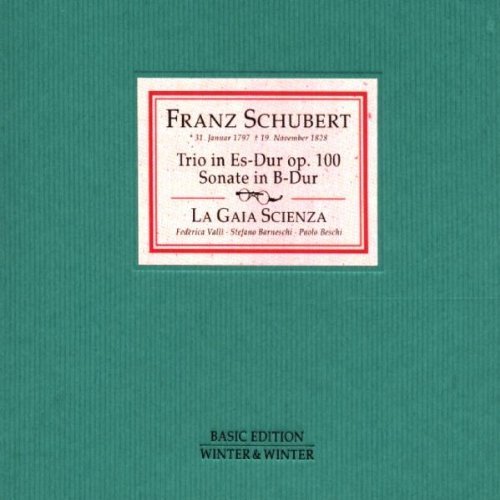
La Gaia Scienza - Schubert: Piano Trios (1998)
BAND/ARTIST: La Gaia Scienza
- Title: Schubert: Piano Trios
- Year Of Release: 1998
- Label: Winter & Winter
- Genre: Classical
- Quality: APE (image+.cue,log)
- Total Time: 01:42:34
- Total Size: 414 Mb
- WebSite: Album Preview
Tracklist:
CD 1:
Trio in E-flat Major for Piano, Violin and Cello, Op. 100, D. 929
I. Allegro 15:22
II. Andante con moto 8:44
III. Scherzando: Allegro Moderato 6:58
IV. Allegro Moderato 13:47
Sonata in B Major for Piano, Violin and Cello, D. 28 10:33
CD 2:
Trio in B Major for Piano, Violin and Cello, Op. 99, D. 898
I. Allegro moderato 13:57
II. Andante un poco mosso 9:47
III. Scherzo 6:28
IV. Rondo 8:25
Trio Notturno in E-flat Major for Piano, Violin and Cello, Op. 148, D. 897: Adagio 8:25
Performers:
La Gaia Scienza:
Federica Valli, fortepiano
Stefano Barneschi, violin
Paolo Beschi, cello
CD 1:
Trio in E-flat Major for Piano, Violin and Cello, Op. 100, D. 929
I. Allegro 15:22
II. Andante con moto 8:44
III. Scherzando: Allegro Moderato 6:58
IV. Allegro Moderato 13:47
Sonata in B Major for Piano, Violin and Cello, D. 28 10:33
CD 2:
Trio in B Major for Piano, Violin and Cello, Op. 99, D. 898
I. Allegro moderato 13:57
II. Andante un poco mosso 9:47
III. Scherzo 6:28
IV. Rondo 8:25
Trio Notturno in E-flat Major for Piano, Violin and Cello, Op. 148, D. 897: Adagio 8:25
Performers:
La Gaia Scienza:
Federica Valli, fortepiano
Stefano Barneschi, violin
Paolo Beschi, cello
This provides a most welcome sequel to La Gaia Scienza’s splendid account of the E flat Schubert Trio (Winter & Winter, 12/97). On that disc Federica Valli plays a Schantz fortepiano with an extremely pungent range of sonorities; here she exchanges it for an 1827 Conrad Graf instrument that is rather more suave and silvery, though recorded with equal immediacy. Indeed, the recording brings out most vividly the character of all three instruments – listen to the start of the Notturno, where the harp-like piano chords contrast most picturesquely with the grainy tone of the gut-strung strings. The memorable sound of the record is complemented by playing of exceptional physical vitality; in the triumphant middle section of the Notturno, any limitation of the sonorous impact due to the period piano is more than offset by the sheer impetus of the playing. The lightness and vivacity of D898’s finale and the forceful vigour of the first movement are equally notable.
For a period-instrument version of the Trio, this is a strong recommendation. On modern instruments, Schiff, Shiokawa and Perenyi are serious rivals – less immediately striking in terms of sound, but offering interpretations of exceptional insight and expressive range. And their two-CD set of the Trio also includes a wonderful performance of the Arpeggione Sonata. To combine the virtues of these versions of the B flat Trio, you would have to go back to the famous 1926 Cortot/Thibaud/ Casals recording.'
For a period-instrument version of the Trio, this is a strong recommendation. On modern instruments, Schiff, Shiokawa and Perenyi are serious rivals – less immediately striking in terms of sound, but offering interpretations of exceptional insight and expressive range. And their two-CD set of the Trio also includes a wonderful performance of the Arpeggione Sonata. To combine the virtues of these versions of the B flat Trio, you would have to go back to the famous 1926 Cortot/Thibaud/ Casals recording.'
As a ISRA.CLOUD's PREMIUM member you will have the following benefits:
- Unlimited high speed downloads
- Download directly without waiting time
- Unlimited parallel downloads
- Support for download accelerators
- No advertising
- Resume broken downloads


